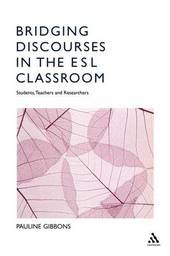
|
Bridging Discourses in the ESL Classroom: Students, Teachers and Researchers
Paperback / softback
Main Details
| Title |
Bridging Discourses in the ESL Classroom: Students, Teachers and Researchers
|
| Authors and Contributors |
By (author) Dr Pauline Gibbons
|
| Physical Properties |
| Format:Paperback / softback | | Pages:256 | | Dimensions(mm): Height 234,Width 156 |
|
| ISBN/Barcode |
9780826455376
|
| Classifications | Dewey:306.446 |
|---|
| Audience | | Postgraduate, Research & Scholarly | | Professional & Vocational | |
|---|
|
Publishing Details |
| Publisher |
Bloomsbury Publishing PLC
|
| Imprint |
Continuum International Publishing Group Ltd.
|
| Publication Date |
30 June 2006 |
| Publication Country |
United Kingdom
|
Description
Bridging Discourses in the ESL Classroom examines the interactions between learners and teachers in the language classroom. It aims to identify patterns of discourse which enable second language development but also support the learning of curriculum knowledge. These patterns are 'bridging discourses' in that they combine the everyday language used by the student, with the specialised language of the academic register. This book puts forward an innovative new theory of classroom discourse analysis, influenced by the work of Halliday and Vygotsky. It is recommended for academics and postgraduates researching applied linguistics and education.
Author Biography
Pauline Gibbons is Adjunct Professor of TESOL at the University of New South Wales, Australia.
ReviewsGibbons presents a compelling argument for teachers to be critically aware of their own language uses, as they enable collaborative dialogues with and amongst their students. For teachers, researchers and students in linguistics and education, this book is an invaluable resource. * Barbara Lasserre, Lecturer, ELSSA * [This] detailed systematic investigation of real life classroom discourse offers great potential for teacher training purposes and also provides a valuable classroom-based research resource for anyone concerned with ESL learners' linguistic and academic growth. -- Jingjing Qin * Studies in Second Language Acquisition *
|